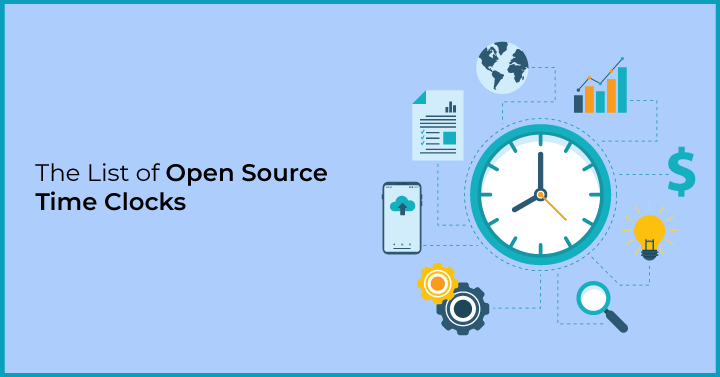In the 1800s, manual time cards were the only way to track employee time. These entries confirmed that a worker entered and left a workplace on time and that employers weren’t cheating them out of their wages. How times have changed! And with it, the tools we use. Today, there is a plethora of licensed, proprietary and open-source timesheet software (also known as open-source timesheet software) to keep track of logins, logouts and at-work productivity.Open-source tools come under licensing policies and are preferred by communities, individuals and businesses who wish to reuse and modify the original source code. It's more widely shareable, as opposed to proprietary software that limits usage to a specific number of users. The other downside is that licensed tools do not allow the original code to be altered in any way.A timesheet software that is open source prevents misuse of company time via buddy punching, time theft, unverified overtime and proxy attendance.In this article, we’ll go into what an open-source timesheet software is, and review a few tried and tested platforms."To explore various kinds of remote team management software that can serve as catalysts to boost organizational efficiency at the workplace, read our informative article that covers it all here."1 What is open-source attendance software?
 Open-source attendance software is a platform that enables businesses to meet their attendance goals. It reports on the consistency of attendance as entered by employees and ensures that the time they spend at work contributes to the business. In other words, that the employees' time is spent constructively. An open source timesheet management system tracks and monitors an employee’s attendance pattern. It also records absences and helps employers investigate and mitigate avoidable absences. A open source timesheet system helps employees systematically plan out their schedule and fit in meaningful work. The components of attendance management and timesheet tools are;
Open-source attendance software is a platform that enables businesses to meet their attendance goals. It reports on the consistency of attendance as entered by employees and ensures that the time they spend at work contributes to the business. In other words, that the employees' time is spent constructively. An open source timesheet management system tracks and monitors an employee’s attendance pattern. It also records absences and helps employers investigate and mitigate avoidable absences. A open source timesheet system helps employees systematically plan out their schedule and fit in meaningful work. The components of attendance management and timesheet tools are;- Payroll integration
- Absenteeism management
- Biometrics
- Remote logins
- Time tracking
- Compliance reporting
The benefits of an open source timesheet management system are;- No vendor lock-in: On buying the license and deploying the tool, it becomes yours to upgrade as and when required. Instead of waiting for a newer release from the vendor, you can source it from the community or create it yourself. You can alter the source code without relying on the vendor to fix issues.
- Lower maintenance costs: Timesheeet open source is more budget-friendly and helps you start small before your needs grow. You get the same capabilities for a fraction of the installation and setup costs.
- More scalable and flexible: You aren’t buying an off-the-shelf product. The fact that you can customize it without relying on the vendor means that your product scales up or down as you want it to. The community involvement factor lets you share the cost of maintaining and sustaining applications among multiple parties.
Now that we’ve seen a few benefits of an open-source attendance management system, it's time to check out a few open-source timeclocks!2 The List of Open Source Time Clocks
2.1 eHour
About
eHour is a free, open-source time tracking software. It's used by over 7000 users and is web-based. You can download eHour1 for basic time tracking and reporting, while the cloud version comes with automated time tracking, project task time tracking and approval workflows.Time clock features
Weekly timesheets, team-oriented tooling, reports and integration are this open-source timesheet software’s core features. Timesheets give you an overview of project time. You can modify hours manually, add notes to entries, request workflow approvals and lockdown on a timesheet.What we like about it:
The cloud version is optimized for multi-device compatibility and is always available. You can use the expense feature in the 14-day free trial to test out how much you’re spending for inflight projects.What we dislike about it
The facility to categorize tasks within a project is time-consuming and doesn’t always get auto-populated.2.2 Timeclock Hub

About
Timeclock hub a free employee time clock with built-in scheduling and payroll reporting. You can download it from either the Play Store or Apple’s App Store. Time clock features
Under employee time tracking and scheduling, Timeclock hub features comprise paid time-off tracking, remote employee tracking, assigning and managing tasks and expense report tracking. Payroll integrations and reimbursement reports streamline your payroll. The time clock features include GPS tracking, photo captures, deduction reports and the option to customize overtime per employee.What we like about it:
The photo capture snaps shots of the employee, confirming his or her identity when they check-in. We also like how simple it is to factor in paid time offs, overtime and expense receipts before tallying up pay.What we dislike about it
The pricing for the full range of features is a tad expensive for small-sized businesses2.3 ClickUp

About
ClickUp is a free, timesheet open source native time tracking tool with a focus on project management. It’s highly customizable and easy to use, and free for download on the Google Play app store or Apple’s App Store.
Time clock features
ClickUp allows you to track time and schedule tasks on your calendar. You can record work time within each project task and sub-task via manual entry or use the live task timer option. ClickUp also has screen recording, online notepad, and goal tracking features.
What we like about it
We like how easy ClickUp makes time tracking, allowing you to focus on your work. With it, you can track time, set estimates, add notes, and view reports of your time from anywhere. It also integrates with many popular time tracking tools such as Toggl, Harvest, and Clockify.
What we dislike about it
Nothing so far. It’s free, and available for nearly every device on the market.
2.4 Opentimeclock
About
Opentimeclock is a web-based open source timesheet software. This free employee time management app is designed to track employee's time, attendance, paid time off accruals, scheduled shifts, and time-intensive jobs.Time clock features
It features a simple clock in and clock out, in addition to face recognition and webcam check-in, GPS and map tracking, shift schedule, absences and paid time off.What we like about it:
We like their biometric face clock and facility to scan barcodes of employee badges for personal identification. The shift and schedule option lets you track employees on projects. This tells you if people are consistently punctual, or not. What we dislike about it
Nothing so far. 2.5 Clock It
About
ClockIt is a free time clock tool. Besides a web time clock, there are clocks for Slack, iPhone and Android devices.Time clock features
The primary features are time and attendance management, geolocation and geofencing, shift planning and scheduling, manager dashboard and timecard calculator. It's easy to set up your preferences based on the movement and location of individuals. The biometric clock, for example, works offline and can be applied to only those workers who spend many hours outside of their desks. What we like about it:
We like their attendance auditing and kiosk time clock features. It allows users to clock in and out of one app without needing to log in to the web. You can also set up geofences that the app will work in, thus preventing fake punch-ins and punch-outs.What we dislike about it
Given how comprehensive this open-source timesheet software is, we don’t feel it's missing any key time clocking and tracking feature.2.6 Project Hamster

About
Project Hamster is touted as the best time tracking and attendance management system for individual contributors (think freelancers, contractors, etc). It helps you track the time you spend on chosen activities, projects and functions. Time clock features
Hamster is written into Gitlab’s hub in Python. It lets you group by priorities with categories and tags. It features exportable, interactive reports, idle-time detection, activity reminders and workspace tracking.What we like about it
You can add the Hamster extension to your browser and let it run in the background without distracting you.What we dislike about it
It's not your standard app or web-based time tracker. It works best for individuals who are code-savvy and can handle a little GitHub. 2.7 Clockify

About
Clockify is the team favorite, and I’ve written about it in a previous post on employee timesheet apps for small businesses. You can have unlimited users on it for free.Time clock features
Clockify has an automatic start and stop timer, calendar timelines and dashboards. You can invite the whole team, set hourly rates and view current activities to see what everyone is working on.What we like about it
The facility to mark billable hours, time spent on work using a stopwatch and the ease with which you can enter weekly activities.What we dislike about it
You have to manually stop the timer or risk your hours being inaccurate if you forget.2.8 Baralga

About
Baralga is a lightweight and open-source timesheet software with time tracking. Time clock features
Baralga lets you switch projects with a tray icon. You can record your activities, manually add and edit them and export time reports in Excel or iCalendar formats. plain time tracking What we like about it
Baralga is easy to get started on. You can download the latest version, hereWhat we dislike about it
Since it's a basic time recorder and calculator, it isn’t very feature-rich like the other tools listed. If you’re looking to sync time entries for payroll reconciliation, one of the other tools should serve the purpose.2.9 Kimai

About
Kimai is an open-source time tracking application that first came out in 2006. It accommodates unlimited users and timesheet entriesTime clock features
Kimai has a dashboard, time-tracking and invoicing. You can create teams and group them into departments or by projects. Similarly, you can use activities to assign work and sync hours as timesheet entries. The invoicing feature comes in different templates with calculators and invoice number generators.What we like about it
Kimai lets you create and customize invoices from your timesheets within your browser.What we dislike about it
Expense tracking doesn’t come in the free version. If it's essential to track expenses by customer, project and/or activity, consider getting onto a paid plan.2.10 Pendulums

About
Pendulums is a free time tracking tool that is web and multi-device compatible. The source code for this open source timesheet software is available on Github.Time clock features
You can add as many projects and team members as you like. The charts are user-friendly and display all team members and the time each individual is spending or has spent on tasks within the project they are tagged in. It's easy to assess both team performance and project progress at the same time.What we like about it
We like the rest-time reminder that tells you to take breaks at user-specified time intervals. Offline syncing ensures that you can track your work hours if your internet is down and sync it to the server when you’re back online.What we dislike about it
Nothing so far, it's free, downloadable and easy to use!3 What is the best free time tracking software?

If I had to choose, I’d go with an open-source timesheet software that’s multi-device compatible, affordable (or free), and with features, you can easily get accustomed to. And from this list, my picks are Pendulums, Kimai, Clockify and eHour. If basic time tracking, attendance monitoring and expense management are what you’re after, these tools will get the job done.  Open-source attendance software is a platform that enables businesses to meet their attendance goals. It reports on the consistency of attendance as entered by employees and ensures that the time they spend at work contributes to the business. In other words, that the employees' time is spent constructively. An open source timesheet management system tracks and monitors an employee’s attendance pattern. It also records absences and helps employers investigate and mitigate avoidable absences. A open source timesheet system helps employees systematically plan out their schedule and fit in meaningful work. The components of attendance management and timesheet tools are;
Open-source attendance software is a platform that enables businesses to meet their attendance goals. It reports on the consistency of attendance as entered by employees and ensures that the time they spend at work contributes to the business. In other words, that the employees' time is spent constructively. An open source timesheet management system tracks and monitors an employee’s attendance pattern. It also records absences and helps employers investigate and mitigate avoidable absences. A open source timesheet system helps employees systematically plan out their schedule and fit in meaningful work. The components of attendance management and timesheet tools are;

 Interested in Virtual Team Building Events?
Interested in Virtual Team Building Events?





























